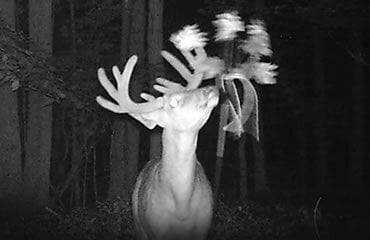How much do you know about whitetail scent cues?
Over the last decade, I have been making mock scrapes using three essential glands lures. If you understand each gland and its purpose, you can use that knowledge while hunting. The success I have experienced has been astounding!
INTERDIGITAL GLAND
White-tailed deer have an interdigital gland near the middle of their hooves on each foot. You must spread the lobes of the hoof apart to see this gland. Between those lobes is a small opening that allows the interdigital gland secretion to be released.
Each deer has a distinct odor. The interdigital gland allows them to identify one another. Each time a deer takes a step, it releases a small amount of the gland secretion.
Why is this so important?
This unique scent allows a mother to locate her fawns. Bucks can find doe beds, check them and follow any doe that might be in estrus. Conversely, non-receptive does go on high alert when they smell the interdigital gland lure from a cruising buck.
Also, whitetails know their home ranges well and like to know if there are intruders. Scent left by the interdigital gland allows them to know when strange deer have entered their territory.
PREORBITAL GLAND
A deer has a preorbital gland just below the corner of each eye. The preorbital gland has two different glands located in the tear duct. The sudoriferous and sebaceous glands are the glands inside the duct. The preorbital glands are controlled by muscles and can open wider to emit an odor.
The primary purpose of the preorbital gland is a tear duct that helps lubricate the eyes. Deer will often put a licking branch in the corner of their eye. The preorbital gland will open and let the liquid from the gland cover the branch. Biologists believe this is a way deer mark territory. Older bucks often have preorbital glands that are more defined, which may be a sign of aggressive behavior toward other deer.
FOREHEAD GLAND
The forehead glands are located above the eyes and between the antlers of a buck. Doe also has forehead glands above their eyes and between their ears. The glands start to produce an oily substance in September. As the rut approaches, the glands secrete more oils. The secretion causes the hair on the buck’s forehead to get darker or appear reddish.
As a buck marks a tree with the oily substance, it leaves information for other deer in the area. A deer can learn three things from a rub. First, it can determine the age of the deer making the rub. Second, a rub can indicate a buck’s social status. Finally, it can communicate to other deer its breeding status.
An older buck secretes more oils from his forehead glands. Thus, older deer mark more trees. Some biologists believe forehead gland secretion has a pheromone that can help a doe come into estrus.
USING GLANDS FOR HUNTING
An interdigital gland lure is excellent to use all year! I run mock scrapes year-round and use an interdigital gland in my scrapes. Whenever I walk in the woods to check cameras or go to my stand, I put an interdigital gland lure on the bottom of my boots. This strategy has helped me harvest many deer.
Preorbital gland lure is my favorite gland to use. I use this gland lure all year in my mock scrapes. You can’t go wrong using a Preorbital gland lure when you hunt. Deer are naturally attracted to this gland lure.
I use Forehead gland lure once I see bucks have shed their velvet. Deer start to produce more forehead secretions as the rut gets closer. I use the forehead gland lure in my mock scrapes and make a few fake rubs. The forehead gland is best used with the Preorbital gland in a mock scrape.
Understanding whitetail glands can take your hunting to another level. An online search can help you find the mock scrape products and gland lures to try. Several companies produce natural and synthetic gland lures. Some have even created tools to make mock scrape setup and gland lures simple and easy to use.
Read Recent Tip of the Week:
• Double Your Fun! Make traditionally unproductive hours count with the help of a friend.




.png)